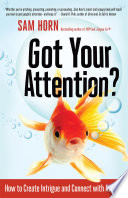

In a world inundated with information, capturing attention has become a critical skill. The book emphasizes that attention is the new currency in the digital landscape. With the rise of social media, advertisements, and content overload, individuals and businesses must develop strategies to stand out. The author discusses various techniques to grab and hold attention, including storytelling, emotional engagement, and leveraging visuals. By understanding the psychology of attention, readers can improve their communication strategies, whether for marketing, personal branding, or leadership.
Continue readingNarratives have the power to captivate audiences and make messages more relatable. The book explores how stories can be effectively used to engage people and keep their attention. The author provides frameworks for creating compelling narratives that resonate with audiences, such as the hero's journey and the use of conflict and resolution. By mastering the art of storytelling, readers can enhance their presentations, marketing campaigns, and even everyday conversations, making their messages more memorable and impactful.
Continue readingVisual content is more likely to capture attention than text alone. The book delves into the science of visual communication and how it can be leveraged to enhance engagement. The author discusses the use of infographics, videos, and images to convey messages more effectively. Additionally, the book highlights the importance of design principles, such as color psychology and layout, in creating visually appealing content. Readers are encouraged to incorporate visuals into their communication strategies to improve retention and understanding.
Continue readingUnderstanding how attention works is crucial for anyone looking to improve their communication skills. The book reviews cognitive psychology research on attention and distraction, explaining how our brains process information and what causes us to lose focus. The author provides insights into the factors that influence attention, such as multitasking and digital distractions, and offers practical tips for minimizing distractions in both personal and professional settings. This knowledge empowers readers to create environments conducive to maintaining attention.
Continue readingEmotional engagement is a key component of capturing attention. The book discusses the importance of connecting with audiences on an emotional level to keep them engaged. The author outlines various strategies for building emotional connections, such as using empathy, authenticity, and vulnerability in communication. By fostering emotional connections, readers can create deeper relationships with their audiences, whether they are customers, team members, or peers, leading to increased loyalty and engagement.
Continue readingIn a world where consumers are skeptical of marketing messages, authenticity has become a vital factor in capturing attention. The book emphasizes the importance of being genuine in communication and the positive effects it has on audience trust. The author discusses how to convey authenticity through storytelling, transparency, and consistent messaging. Readers learn that by being true to themselves and their values, they can create more meaningful connections with their audiences, enhancing their ability to capture and maintain attention.
Continue readingThe book concludes with actionable strategies that readers can implement to capture attention effectively. These strategies include the use of attention-grabbing headlines, engaging hooks, and interactive content. The author also stresses the importance of understanding the target audience and tailoring messages accordingly. By applying these practical tips, readers can improve their ability to engage others, whether in marketing, leadership, or personal interactions, ultimately leading to more successful outcomes.
Continue reading